Designing a functional, motivating home gym doesn’t have to consume an entire wing—or your wallet. Recent guides on space-savvy fitness rooms, fold-away cardio tech, smart strength tools, and wellness-centric décor show that any spare corner can evolve into a purpose-built training zone. Below you’ll find twenty practical ideas, each distilled into a single 100-to-120-word action plan. Every concept spotlights clear benefits, step-by-step tips, and budget-friendly tweaks so you can cherry-pick what suits your square footage, goals, and style. Dive in and let the transformation begin!
1. Garage Multi-Zone Home Gym Transformation
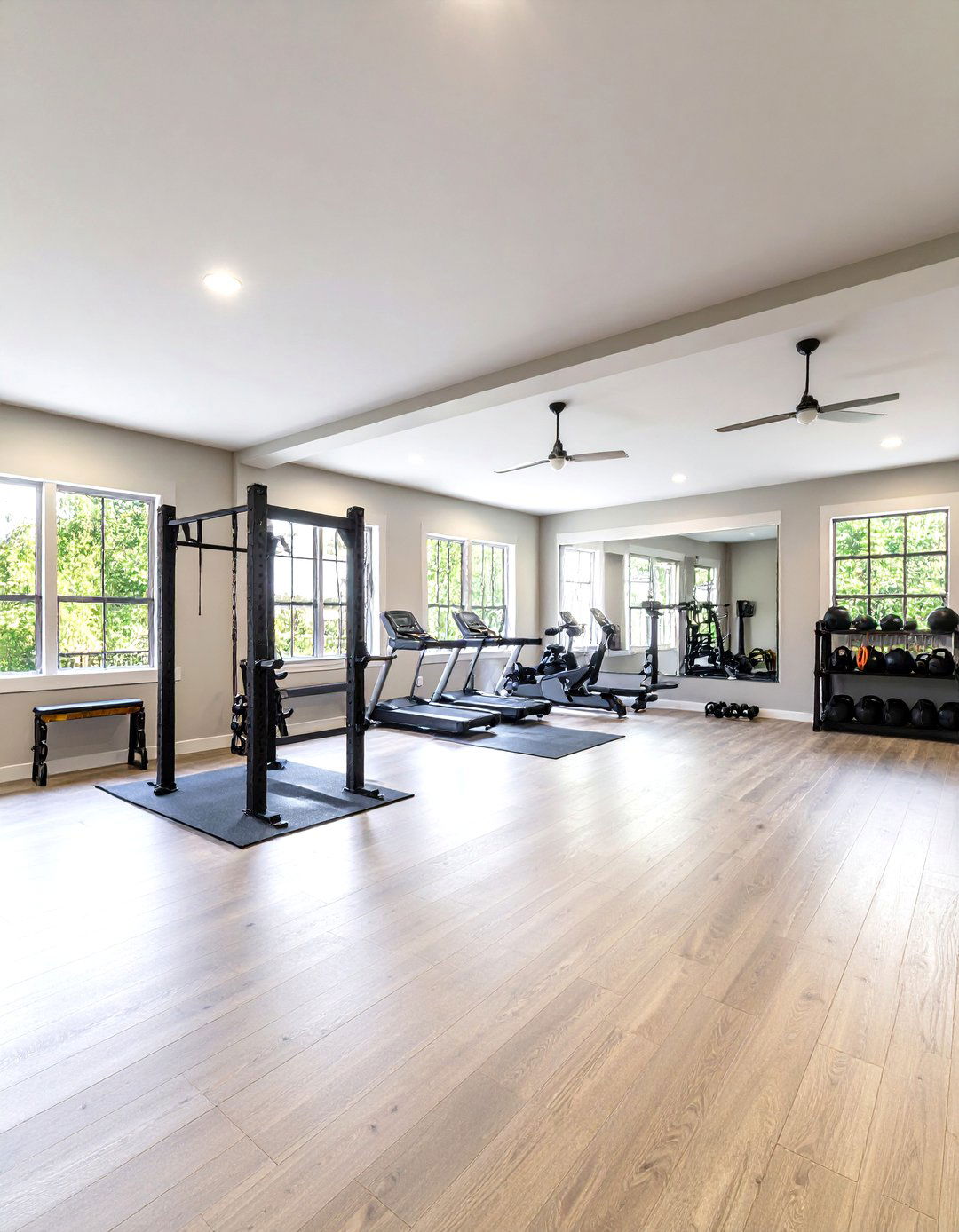
A converted garage offers square footage you can divide into distinct strength, cardio, and recovery pockets without structural drama. Start by sealing floors with durable rubber tiles, then dedicate one wall to a squat rack and bar storage; place cardio machines opposite to prevent traffic jams. Add ceiling-mounted fans and a dehumidifier to mimic commercial-grade ventilation. Modular shelving keeps resistance bands and kettlebells sorted, while a wall mirror doubles visual depth for smaller garages. Incorporating greenery or a moss panel softens the industrial feel and boosts air quality. Extra Space Storage House Beautiful
2. Foldable Treadmill Corner in Your Home Gym
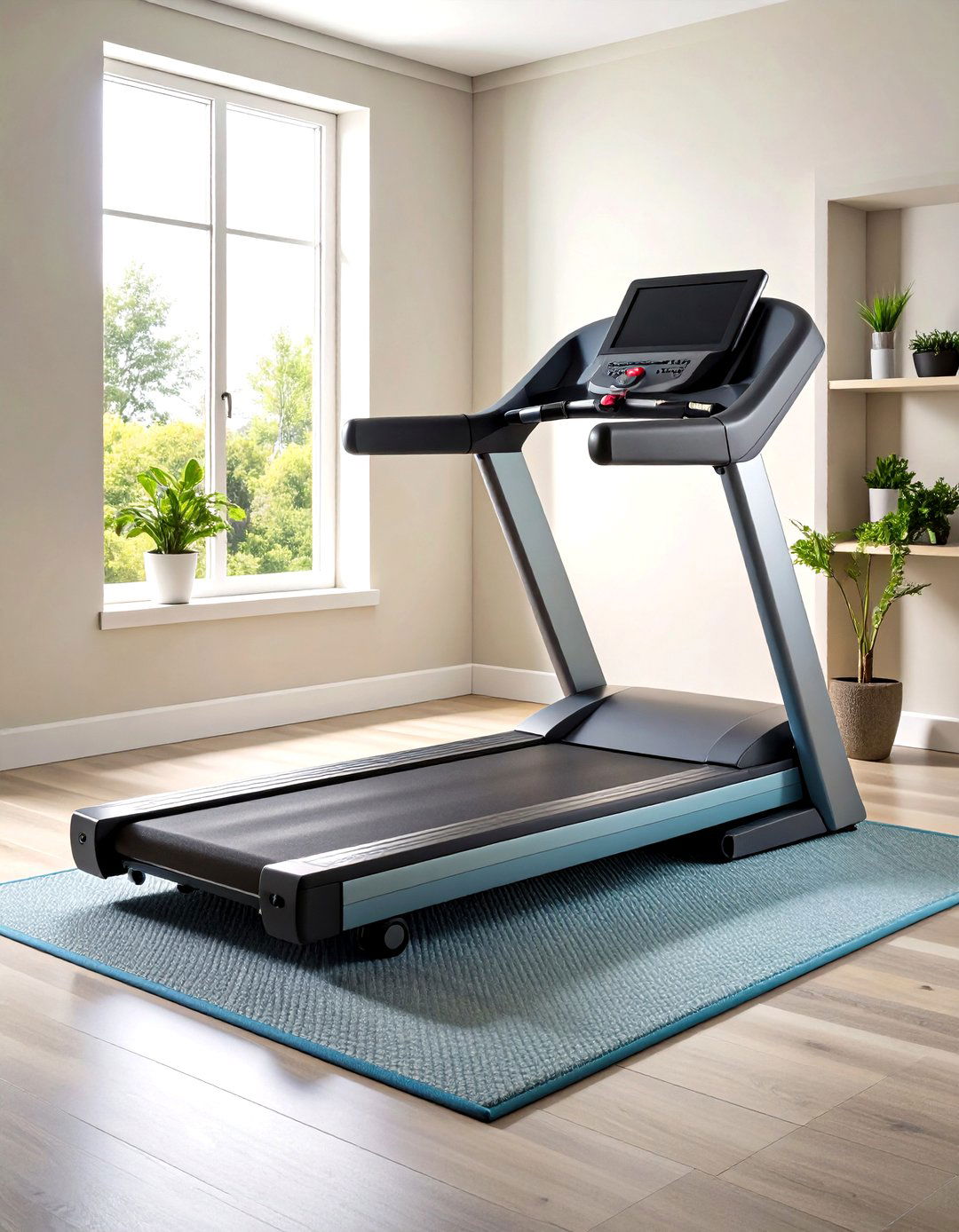
Unlike bulky treadmills of yesterday, compact running or walking pads now fold to just a few inches thick, letting you tuck cardio gear behind a door or under a sofa between sessions. Prioritize models with soft-drop decks and transport wheels to protect floors and simplify relocation. Position the unit near a grounded outlet, then mount a small floating shelf for tablets so streamed classes stay at eye level. A dense mat beneath dampens vibration and protects neighboring rooms. Track usage stats through integrated apps to keep motivation high even in tight quarters. Treadmill Review Guru Verywell Fit Marie Claire
3. Adjustable Dumbbell Station for a Compact Home Gym
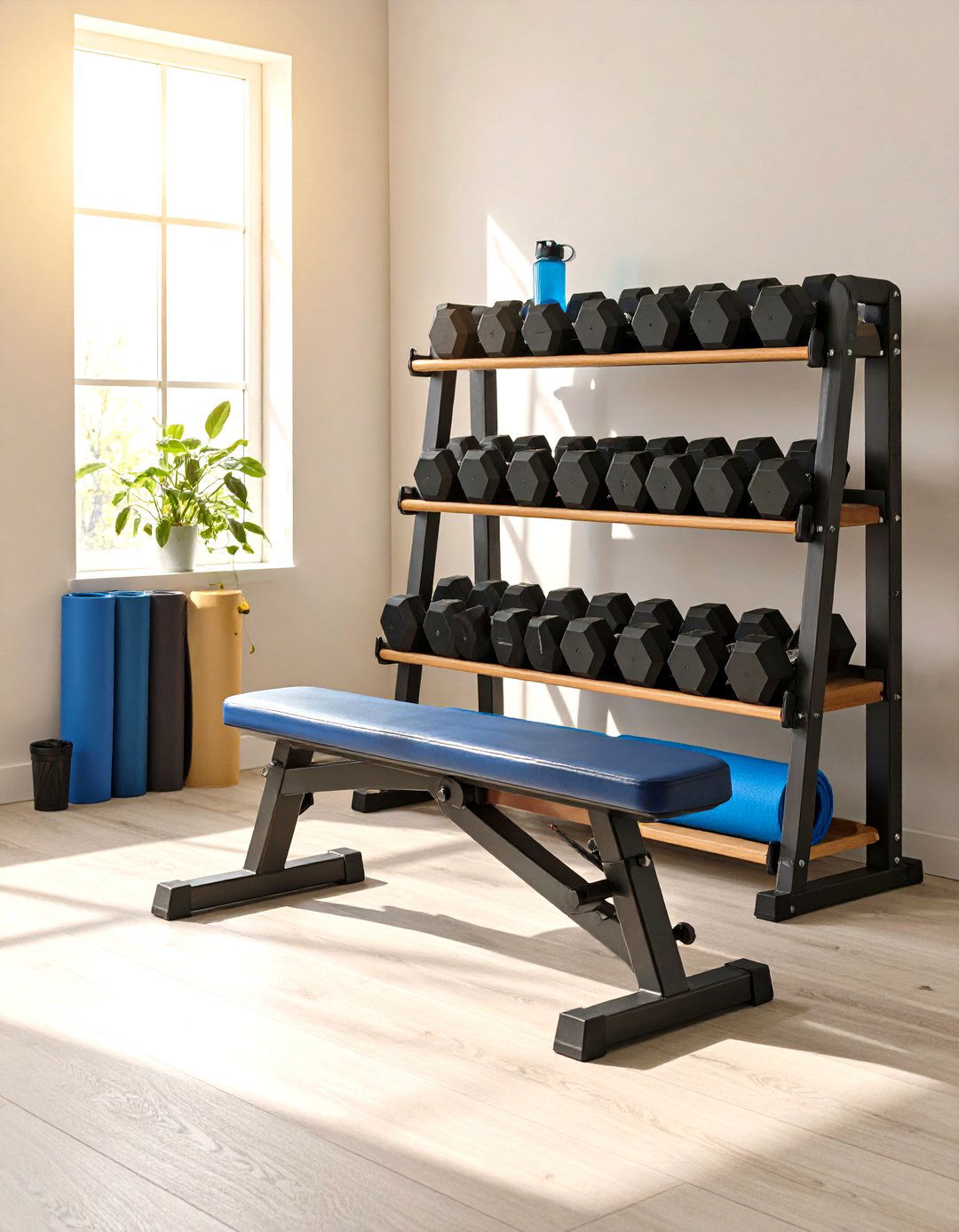
A single pair of dial-adjustable dumbbells can replace an entire rack of fixed weights, saving both money and metres. Situate the cradle on a knee-high utility bench for safe swaps between sets; stow resistance bands or ankle cuffs underneath to maximise vertical space. Because weight ranges now top 80 lb, this minimalist station handles rehabilitation work through to serious hypertrophy training. Keep chalk in a magnetic cup and wipe handles nightly to extend life. When floor area is scarce, this combo punches far above its footprint in training variety and progressive overload potential. Sunny Health & Fitness Garage Gym Reviews
4. Smart Mirror Wall Elevates the Home Gym
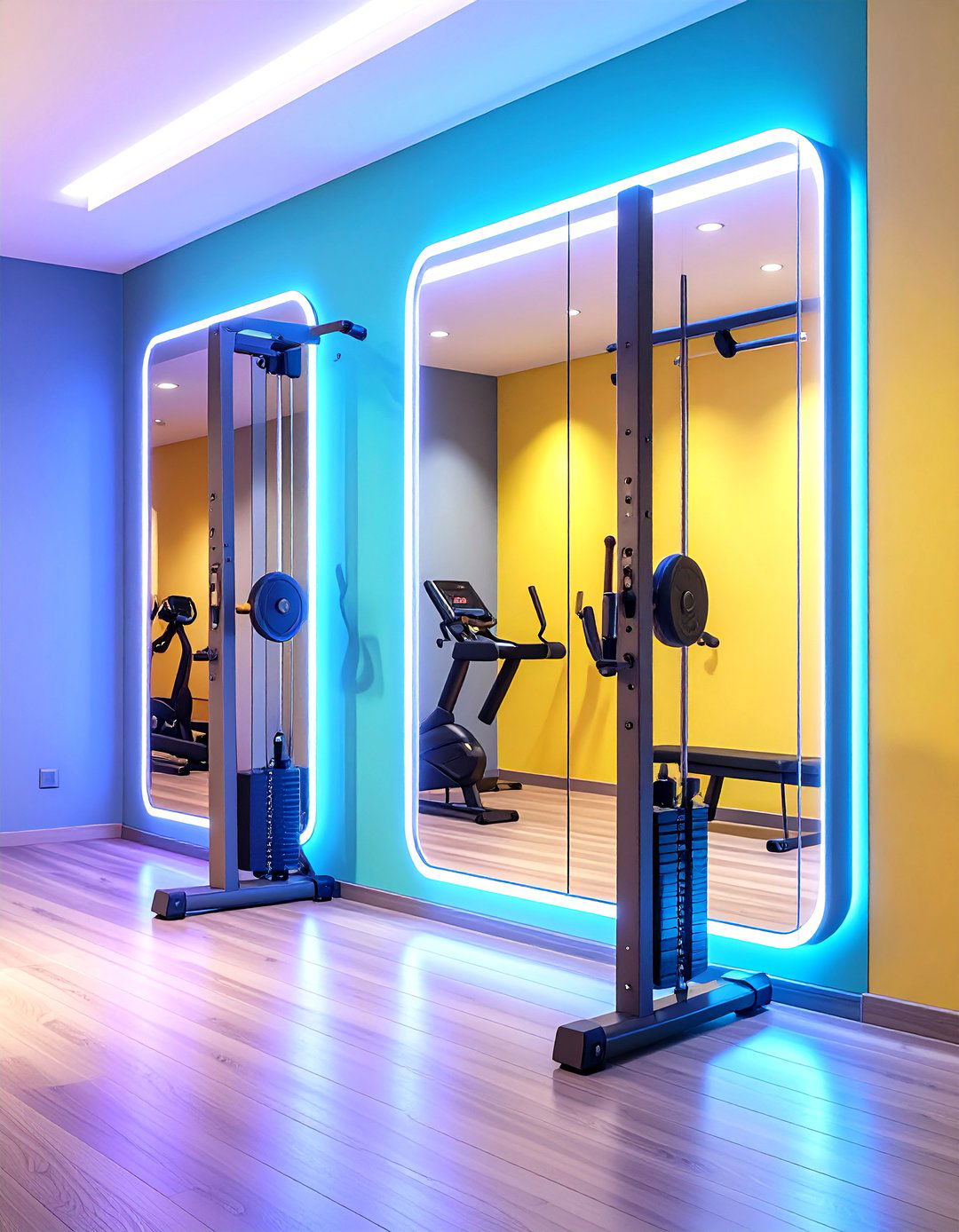
To introduce virtual coaching without clutter, mount an AI-enabled fitness mirror at eye level, leaving two metres of clear floor for movement. Internal sensors provide form feedback, while hidden resistance arms supply up to 200 lb of digital weight, eliminating extra machines. Sync personal playlists or trainer-led classes via Wi-Fi so the mirror doubles as an entertainment hub during cool-downs. Anchor the frame into wall studs for safety, and add soft LED strip lighting behind the glass to create a boutique-studio vibe even in low-ceilinged rooms. Garage Gym Reviews GQ
5. Yoga-Meditation Nook within the Home Gym
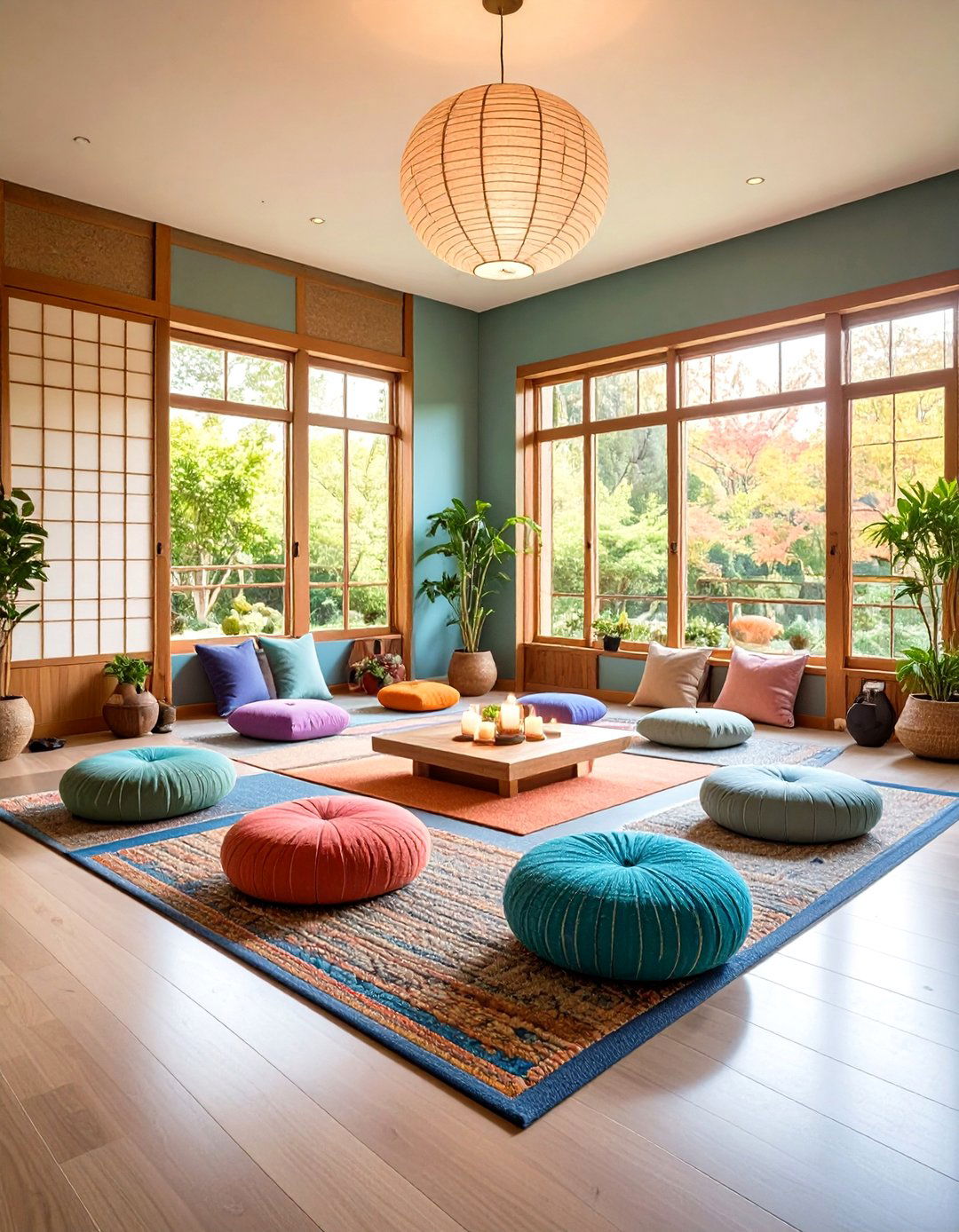
A, simple flooring change—think cork tiles or plush mats—instantly defines a serene corner for breath work and stretching inside a bustling workout area. Layer floor cushions, a salt lamp, and a small stool for water or incense. Natural textures plus potted plants help shift the nervous system from fight-or-flight to rest-and-digest between strength sets. Keep tech out: no screens, only a Bluetooth speaker for ambient tracks. Folding shoji screens or a curtain rod can create privacy if your gym doubles as living space. Displate Blog House Beautiful
6. DIY Pipe Pull-Up Tower for the Home Gym
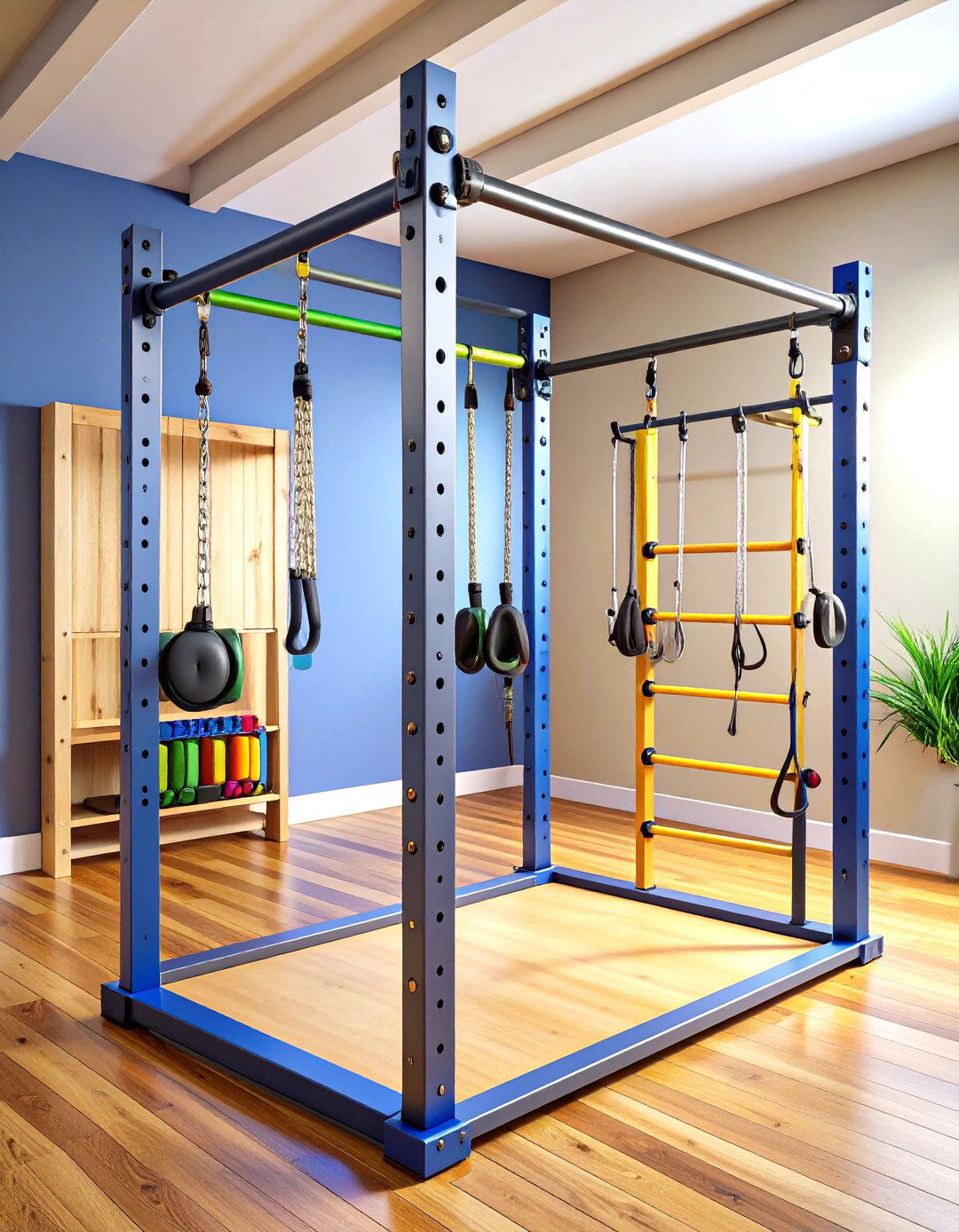
Consider, building a freestanding pull-up and dip station from galvanized pipe and fittings—a weekend project that costs a fraction of commercial rigs yet supports over 300 lb when anchored to plywood. Tailor the height to your reach, and paint with rust-resistant enamel. Multiple grip widths promote balanced shoulder development, while detachable dip handles foster triceps work. Bolt resistance-band pegs near the base for assisted variations, making the unit friendly for every strength level. Simplified Building
7. Under-Desk Walking Pad Home Gym Office
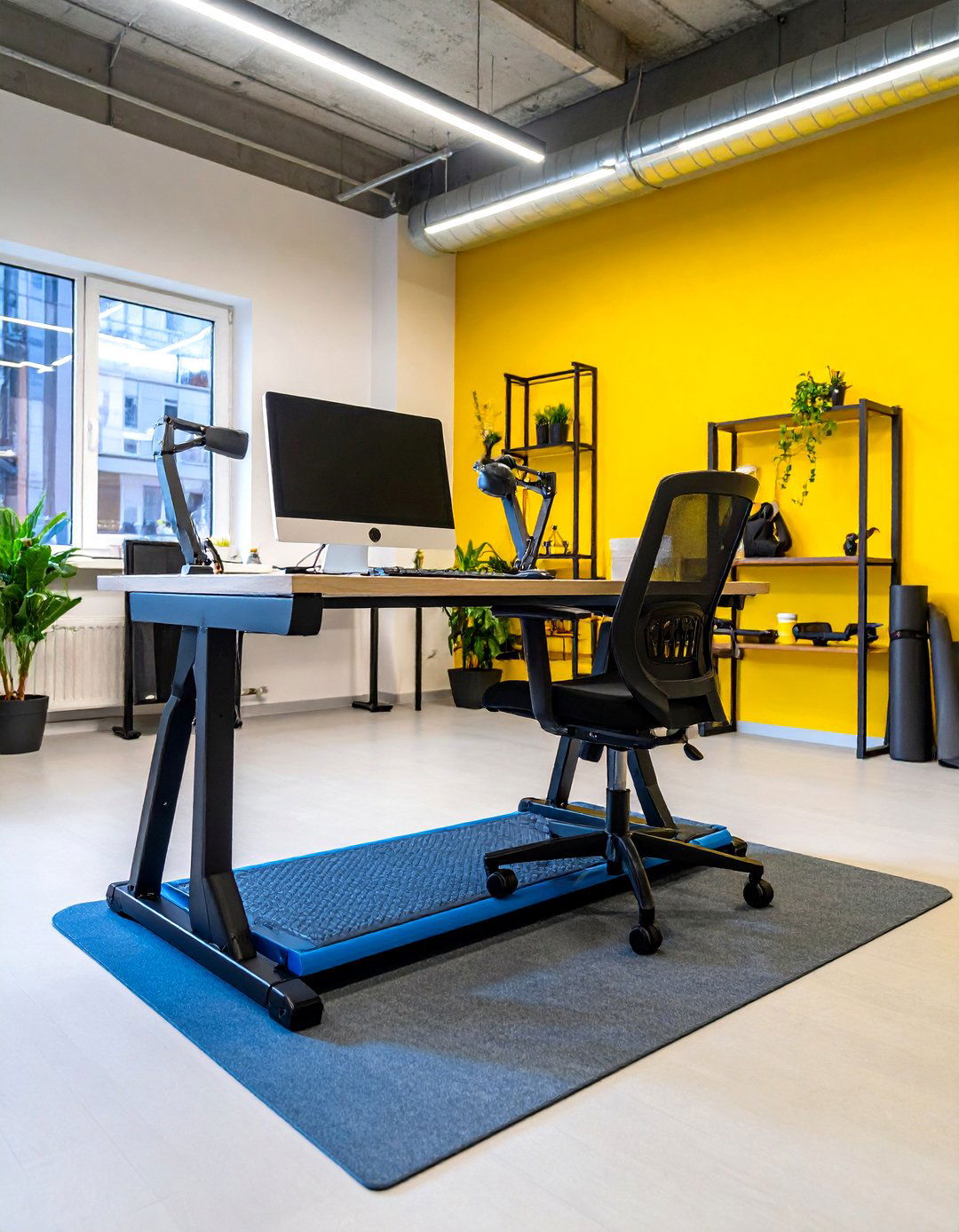
For blended productivity and health, slide a slim walking pad beneath your standing desk and log low-intensity steps during video calls. Select a model under 65 lb with fold-in handlebars for stability yet quick stowage. Set daily mileage alerts through the remote or phone app, and pair with noise-cancelling mats to assure colleagues of quiet meetings. When break time hits, fold the deck vertically, engage the desk’s seated height, and reclaim full office functionality in seconds. Verywell Fit Marie Claire
8. Natural Light & Greenery in the Home Gym
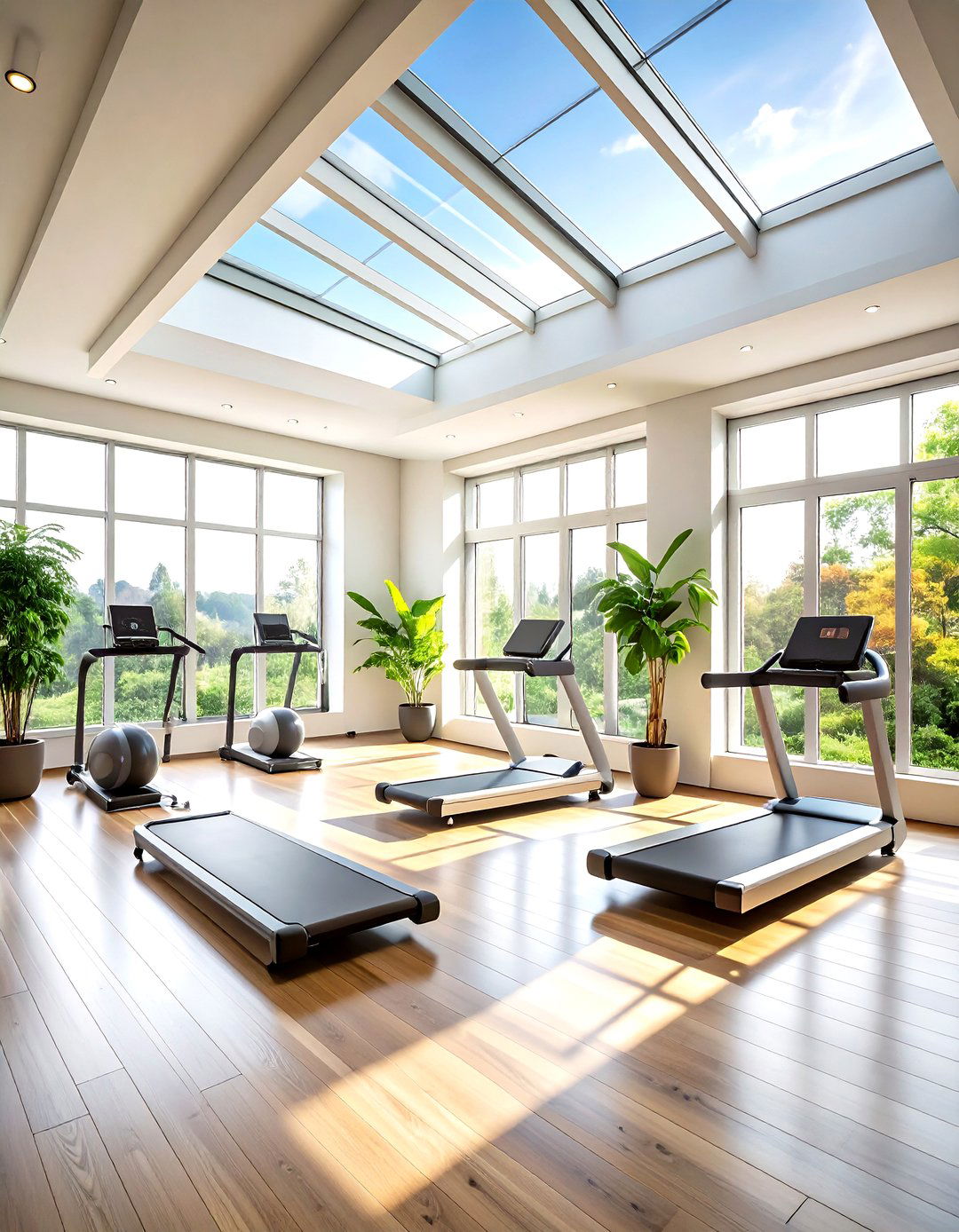
Looking to energize workouts without extra electronics? Swap one solid wall for a full-height mirror opposite south-facing windows, instantly doubling daylight and perceived square footage. Skylights or solar tubes funnel brightness into basement gyms that feel cave-like, while faux plants add life where real foliage won’t thrive. A fresh white or pale gray paint amplifies reflectivity, and adjustable blinds temper glare during screen-based classes. House Beautiful Extra Space Storage
9. Wall-Mounted Storage for a Clutter-Free Home Gym
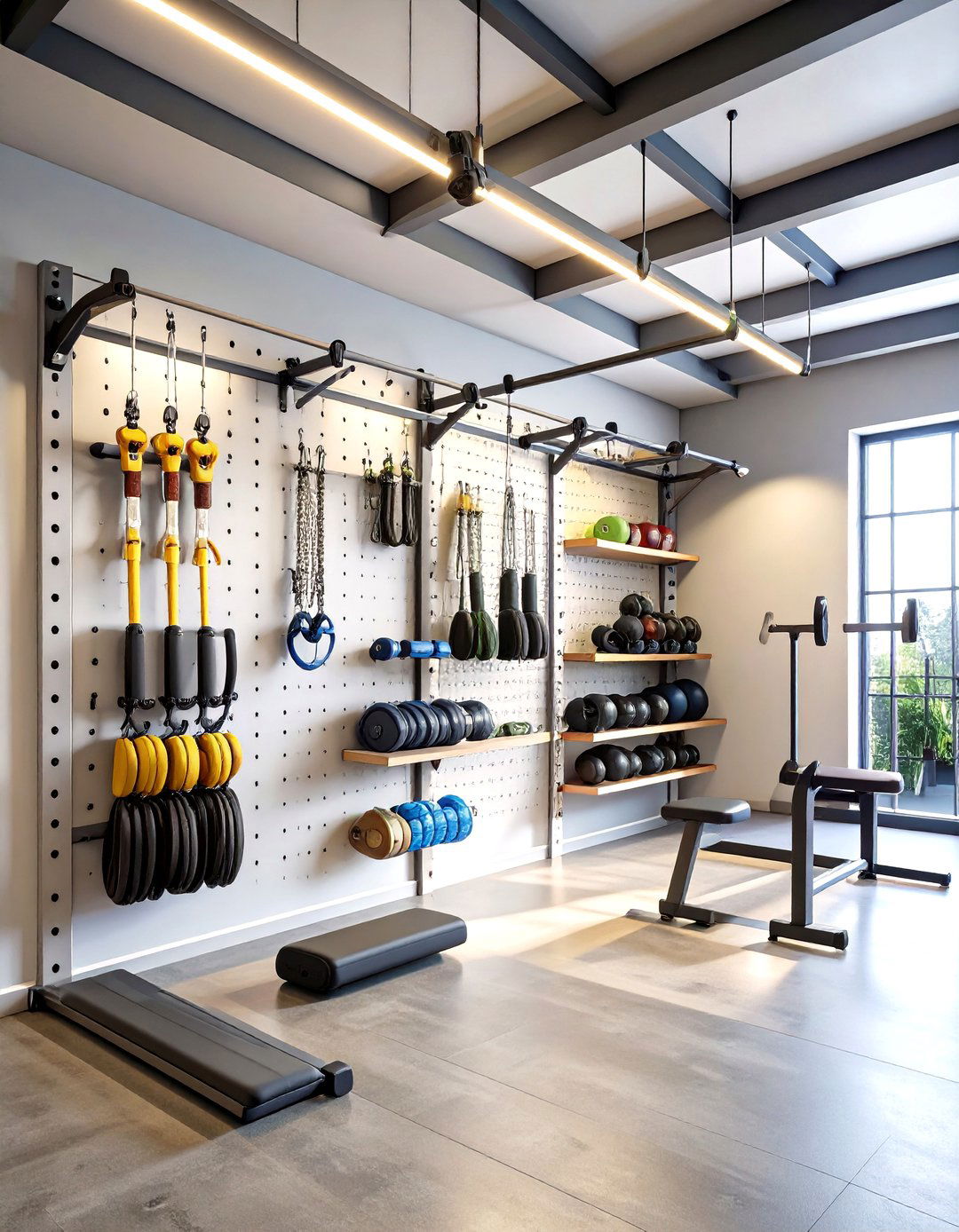
To keep the floor open for movement, screw heavy-duty pegboards or rail racks into studs and assign hooks for each category—bands, jump ropes, belts, mats. Label shelves for chalk, timer, and spray bottles so reset times stay tight. Overhead bike or board racks secure larger items while displaying them like art. This vertical strategy not only protects equipment but also triggers dopamine when you walk into a tidy, ready-to-train zone. House Beautiful Better Homes & Gardens
10. Multi-Station Machine as the Home Gym Powerhouse
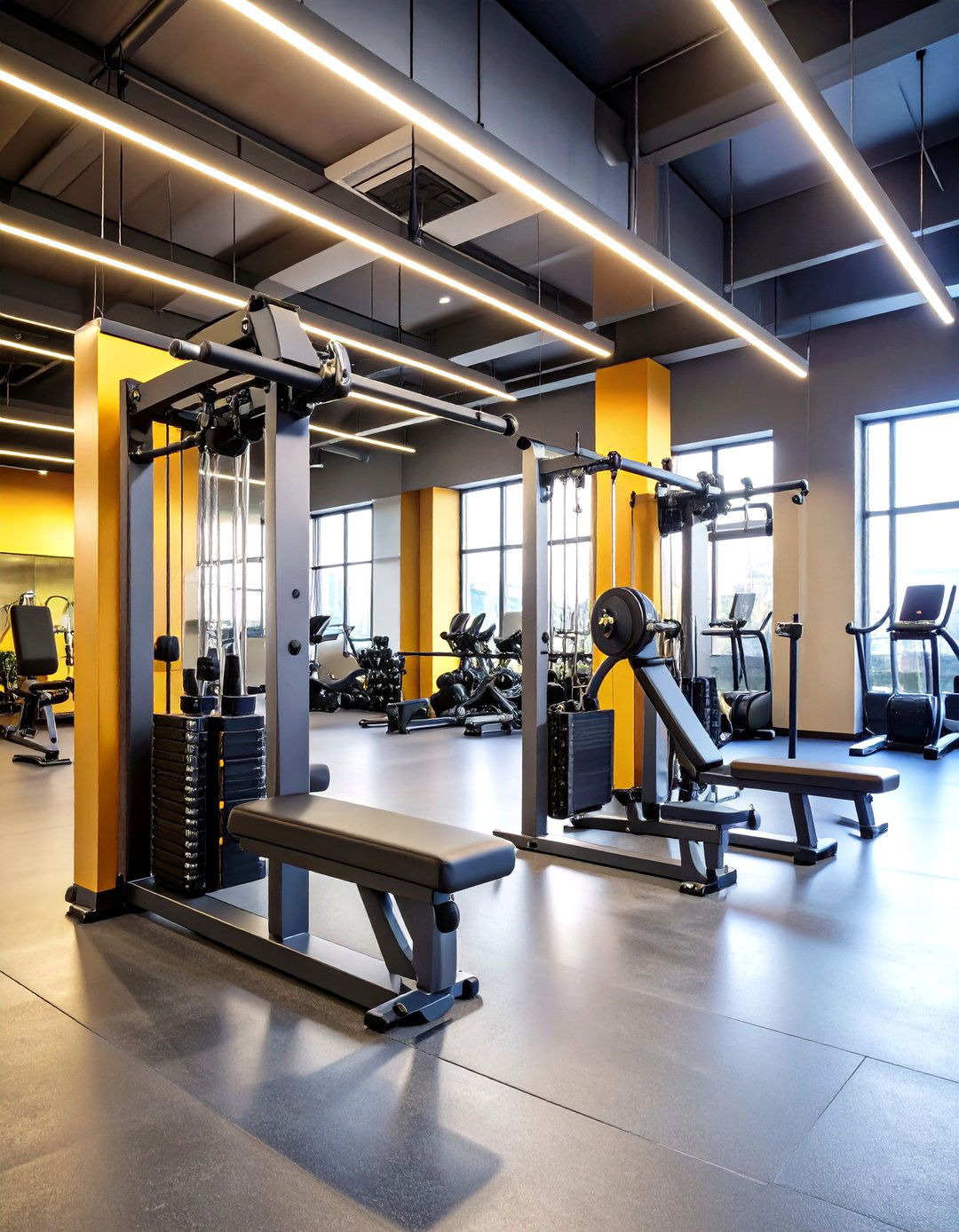
For households wanting barbell-quality resistance yet minimal gear, a compact functional trainer or multi-station gym condenses chest press, lat pulldown, and leg extension into one corner. Prioritize selectorized weight stacks over plate-loaded arms if silence matters in shared walls. Rotate stations every circuit to keep heart rate elevated and sessions short. Swapping cable handles for a triceps rope or ankle cuff takes seconds, so you maximise muscle stimulus without lineup queues. Fitness Factory Garage Gym Reviews
11. Attic Cardio Loft Home Gym

Despite sloped ceilings, an attic can become a sprint studio: low-profile ergometers like rowers or ski trainers slide under eaves, while taller gear occupies the central ridge. Install vibration-damping pads beneath joists and reinforce flooring if adding weight plates. A portable AC or vented skylight prevents heat buildup during summer intervals. Rope lighting along rafters safeguards headroom awareness during explosive moves such as kettlebell swings. Extra Space Storage
12. Basement Strength-Training Home Gym Cave
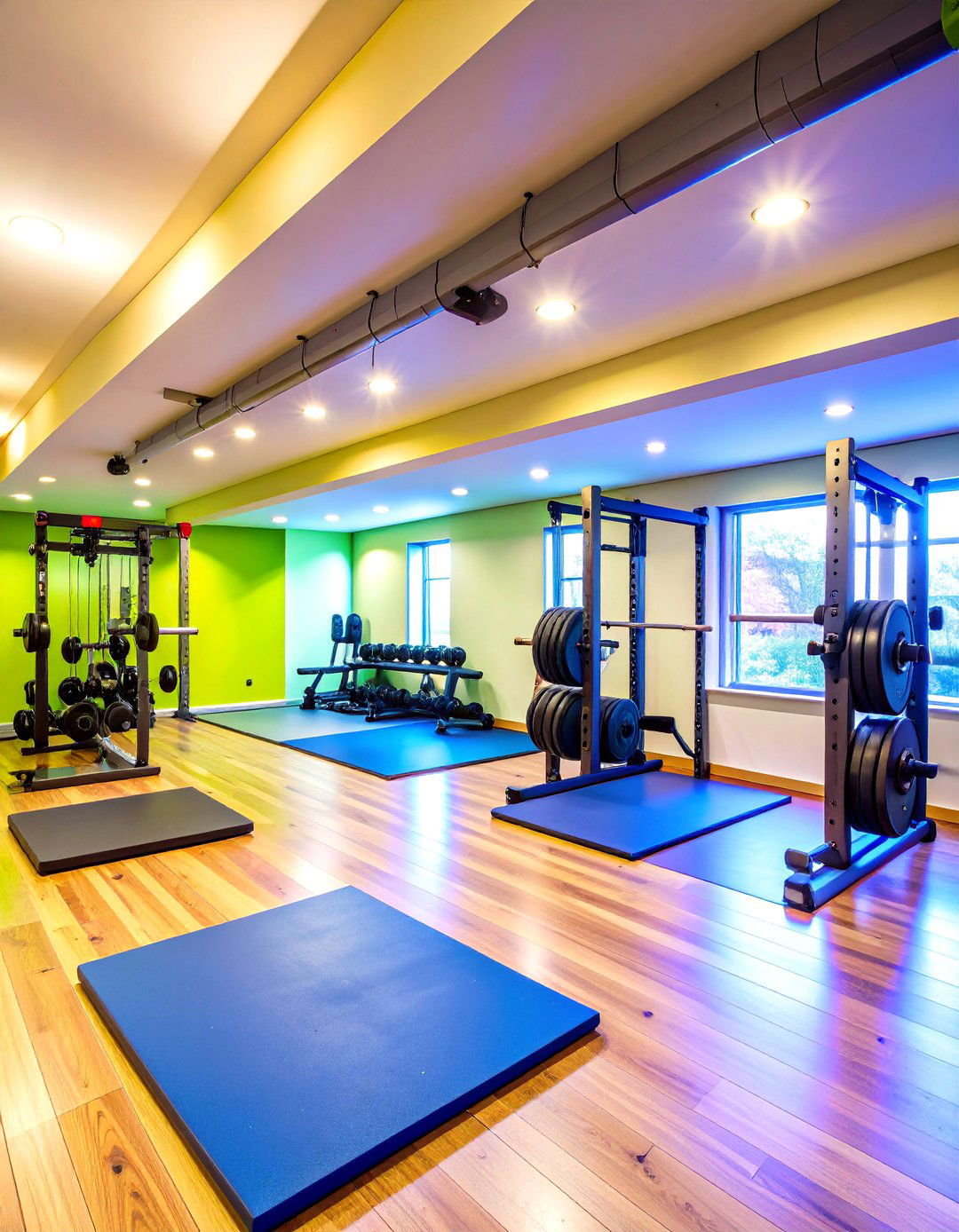
When the ground-floor shake annoys neighbours, shift heavy lifts downstairs. Frame a lifting platform from plywood and stall mats to protect concrete and dampen clang. Bright LED panels simulate daylight, and moisture-resistant white paint counters gloom. Run a wireless repeater to stream technique videos—basements often block signals. Finally, add a mini fridge for hydration and plant-based recovery snacks so you exit workouts nourished, not just exhausted. Extra Space Storage House Beautiful
13. Indoor-Outdoor Sliding Door Home Gym
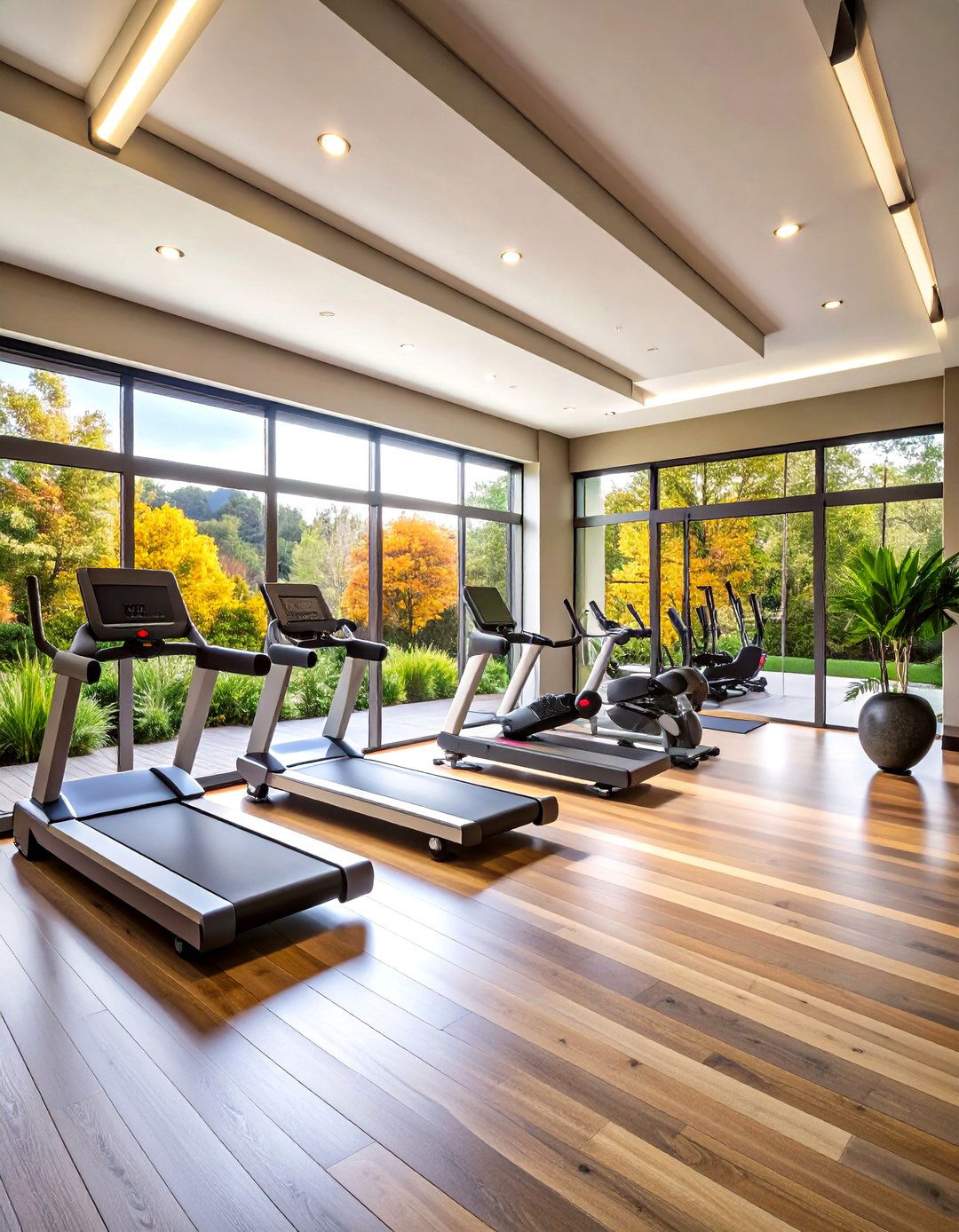
Unlike sealed boxes, a gym that opens onto a patio via bifold or garage doors invites fresh air and vitamin D without sacrificing privacy. Roll cardio machines toward the threshold on cool mornings, then retract inside when weather shifts. Weather-resistant flooring extends outdoors seamlessly, while retractable screens keep bugs out during yoga flows. The sensory hit of birdsong can elevate mood and adherence better than any playlist. Extra Space Storage House Beautiful
14. Budget Sandbag Zone for Functional Home Gym Workouts
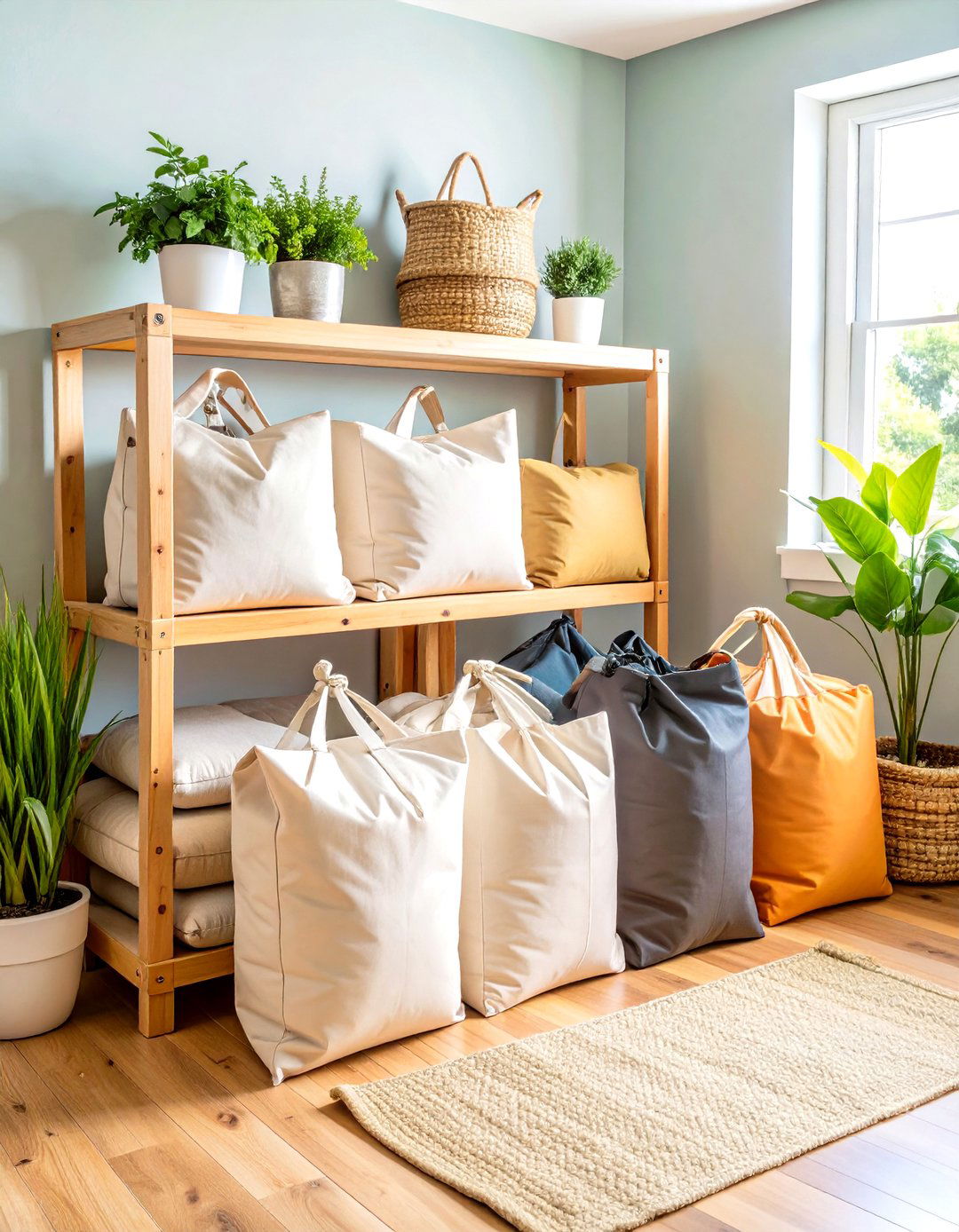
By, filling contractor bags with play sand and housing them in canvas duffels, you unlock deadlifts, cleans, and loaded carries for under $30. Store bags in a milk crate or under a bench; swap weights quickly by adding or removing inner bags. Sand shifts unpredictably, training stabilizers often missed by machines. Pair sessions with pull-ups or sprints for full-body conditioning—minimal gear, maximal grit.
15. Resistance Band Drawer in the Home Gym
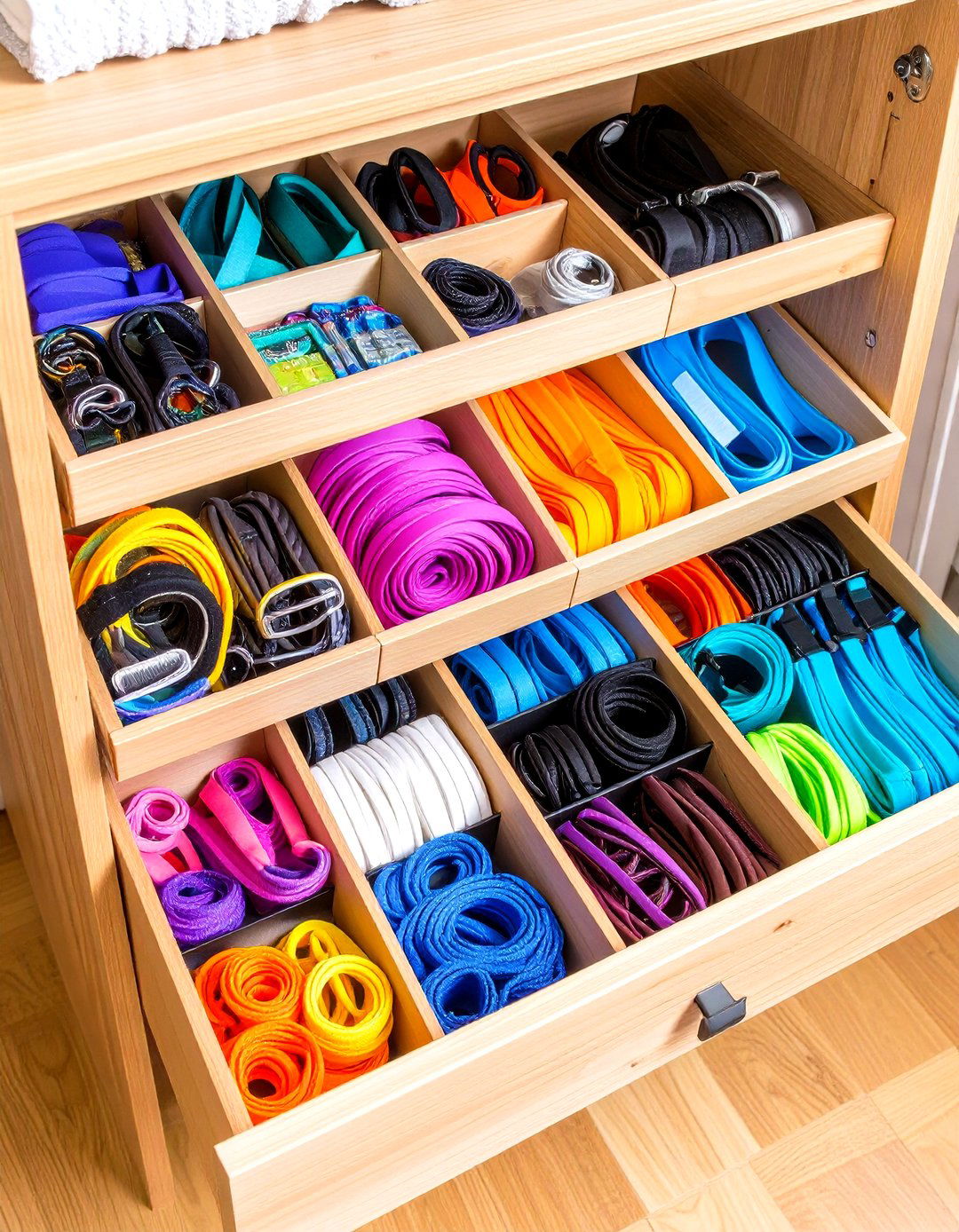
Consider dedicating the bottom drawer of a storage tower exclusively to minibands, hip circles, and floss straps. Colour-coded dividers make load progression instant, while silica packets fend off humidity. Bands excel in warm-ups, active recovery, and joint-friendly accessory work; having them visible nudges consistent prehab habits that stave off injury when barbell ambition grows. Real Homes
16. Virtual Cycling Pod in a Smart Home Gym
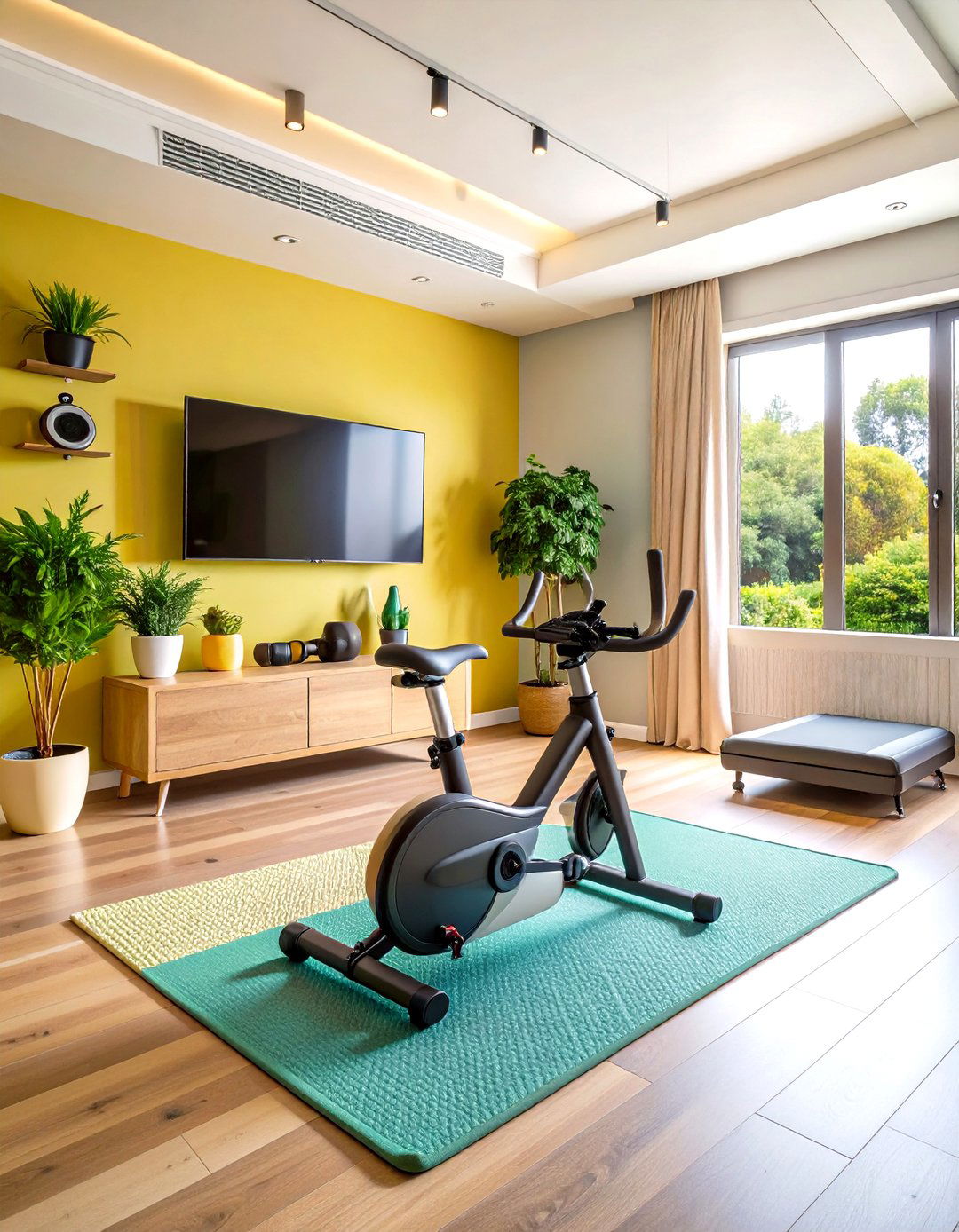
To wrap immersive rides into compact real estate, position a connected bike on a sweat-proof mat facing a wall-mounted display at eye height. Clip fan controls to the handlebars so you don’t dismount mid-climb. Live leaderboards and scenic routes can spike workout duration by 30 % in users tracking engagement data. Parks-inspired wallpapers behind the screen enhance escapism without extra tech. Garage Gym Reviews GQ
17. Rowing & Mobility Corner of the Home Gym
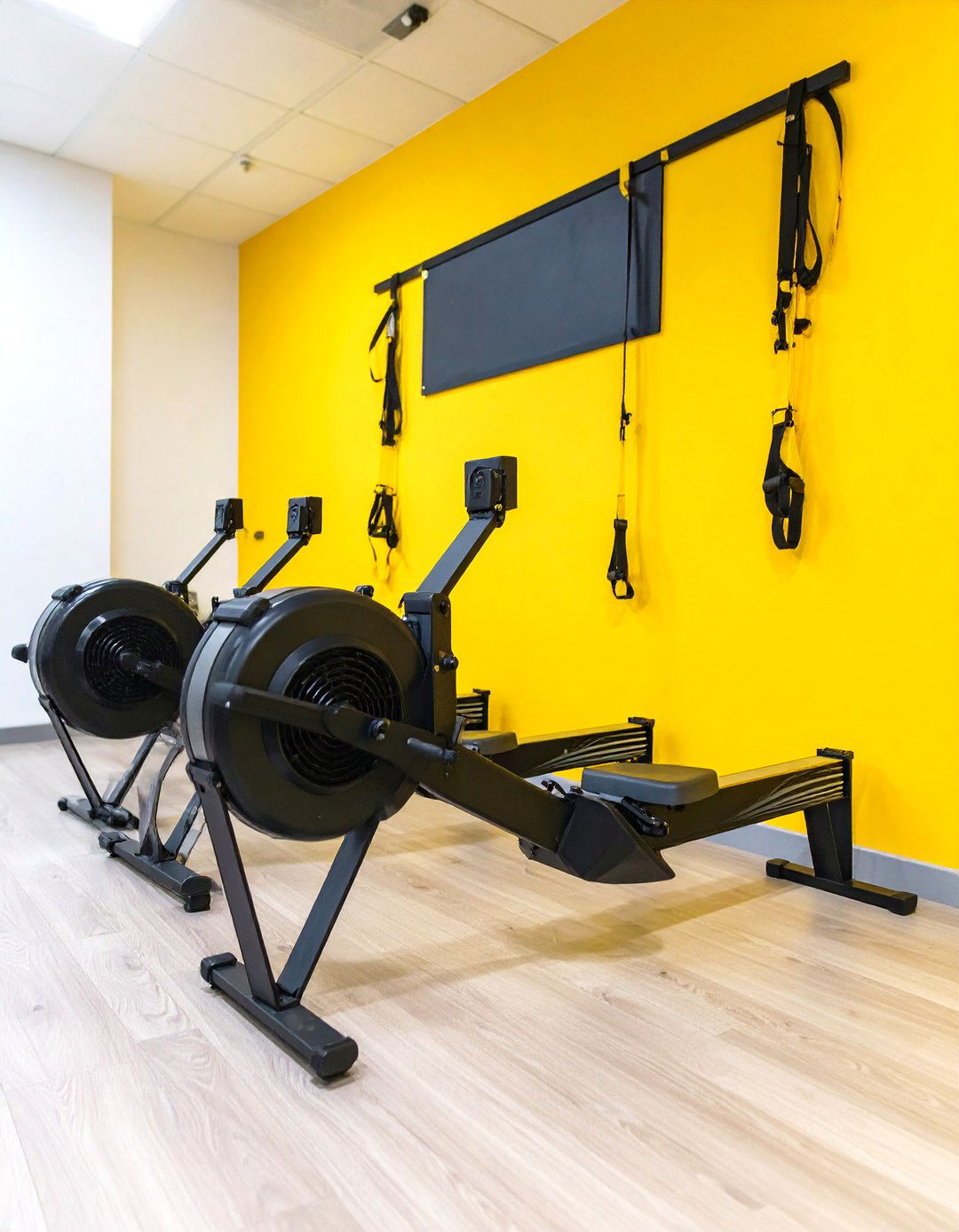
With, rowers now folding upright, you can park one against a wall and unfold only during sessions. Anchor a suspension-trainer strap above the storage spot, turning downtime between intervals into mobility or core supersets. Add a small chalkboard for tracking split times, fostering friendly household competitions and consistent performance gains. Garage Gym Reviews
18. Sound & Music Enhancement for the Home Gym
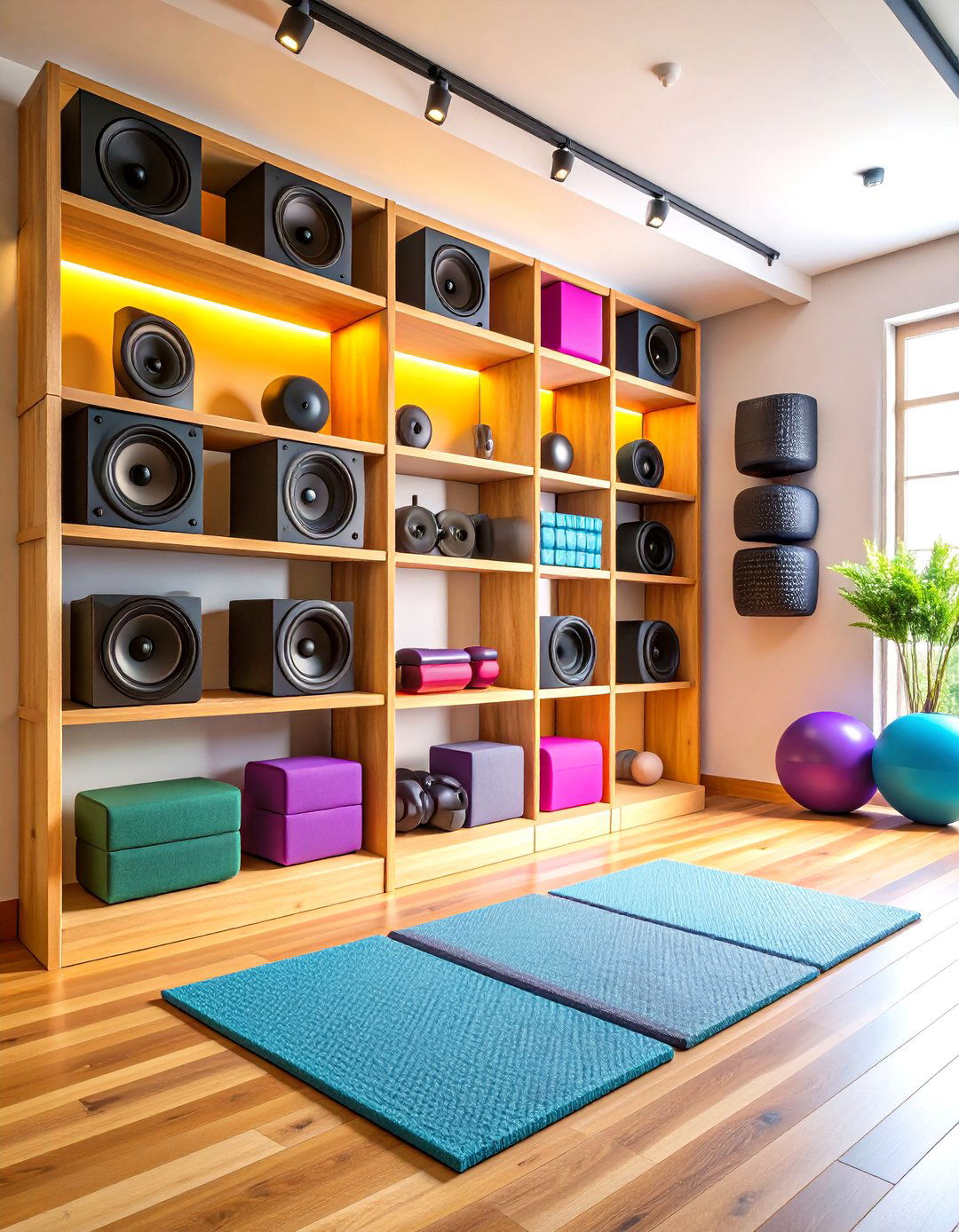
Certainly, music boosts adherence and intensity: compact smart speakers offering 360-degree sound mount safely on high shelves, freeing floor space. Seek units that pair for stereo and support voice control so sweaty hands never fumble playlists. Rug pads or acoustic panels reduce echo in concrete rooms, letting beats energize without neighbour complaints. Garage Gym Reviews Crutchfield
19. Recovery Bay Completing the Home Gym
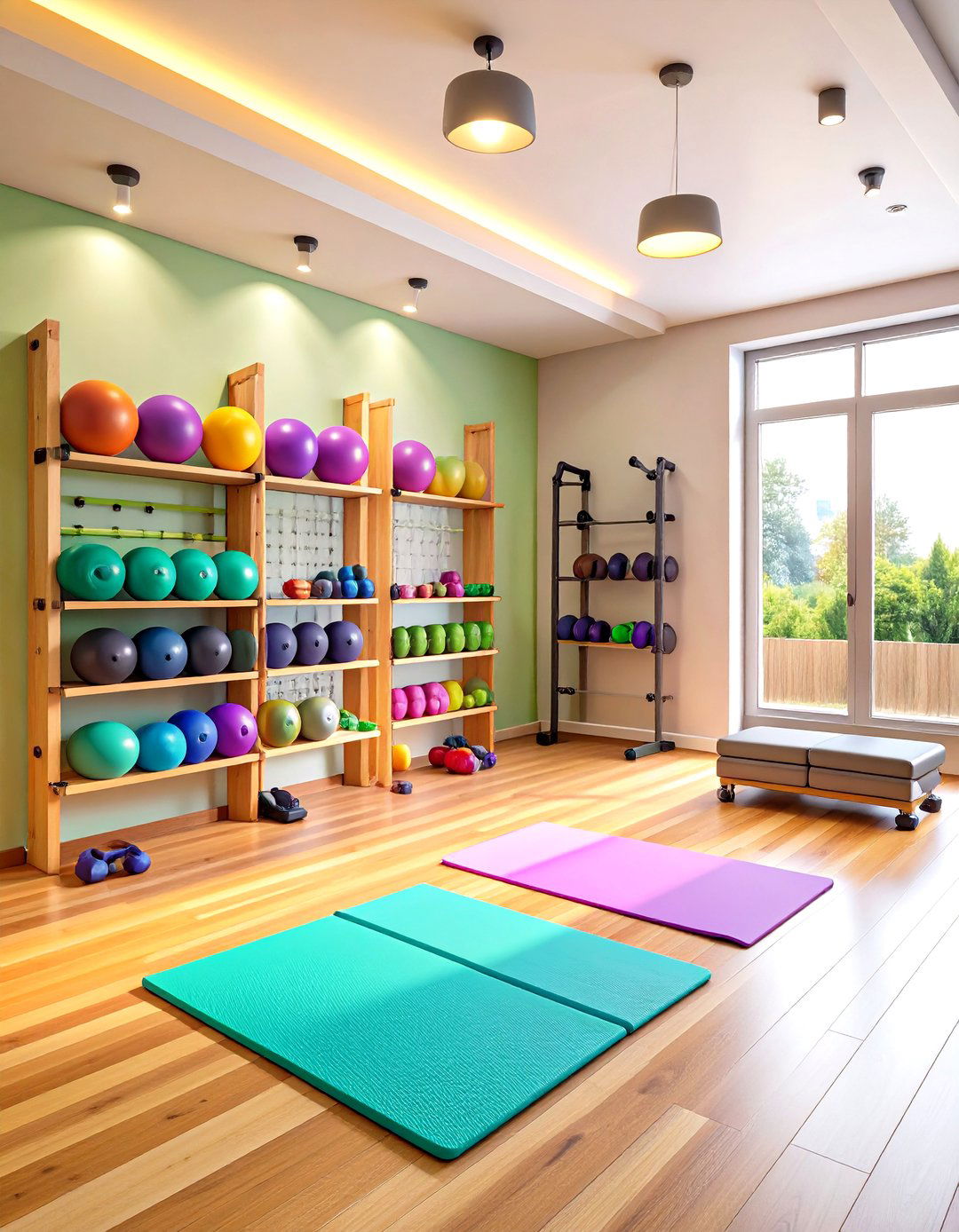
To transition from high-output to restorative mode, designate a corner with wall-mounted foam-roller racks, pegboards for massage balls, and a fold-flat stretching mat. Add a timer that auto-beeps every 30 seconds to pace mobility drills. Vertical storage keeps pathways clear, while a low-watt salt lamp cues calm after adrenaline-charged lifts. Real Homes Better Homes & Gardens
20. Motivating Mood Lighting for the Home Gym

Finally, colour-tunable LED strips around ceiling coves let you shift ambience from energetic reds for HIIT to soothing blues for cool-downs. Paint walls a neutral base—warm gray or off-white—then employ vibrant accent panels so lighting pops without overwhelming. Studies on colour psychology suggest reds raise heart rate, whereas blues lower perceived exertion, enabling smarter session planning. Automate scenes via smart plugs so lights change with programmed workouts. House Beautiful
Conclusion:
Small tweaks—be they fold-up treadmills, pegboard storage, or ambiance-boosting LEDs—can turn almost any nook into a personalized home gym that fuels long-term consistency. By mixing compact equipment with intentional layout, natural elements, and recovery zones, you craft a space that motivates daily movement while respecting household harmony. Pick the ideas that resonate, iterate as you grow stronger, and watch your fitness flourish right where you live.


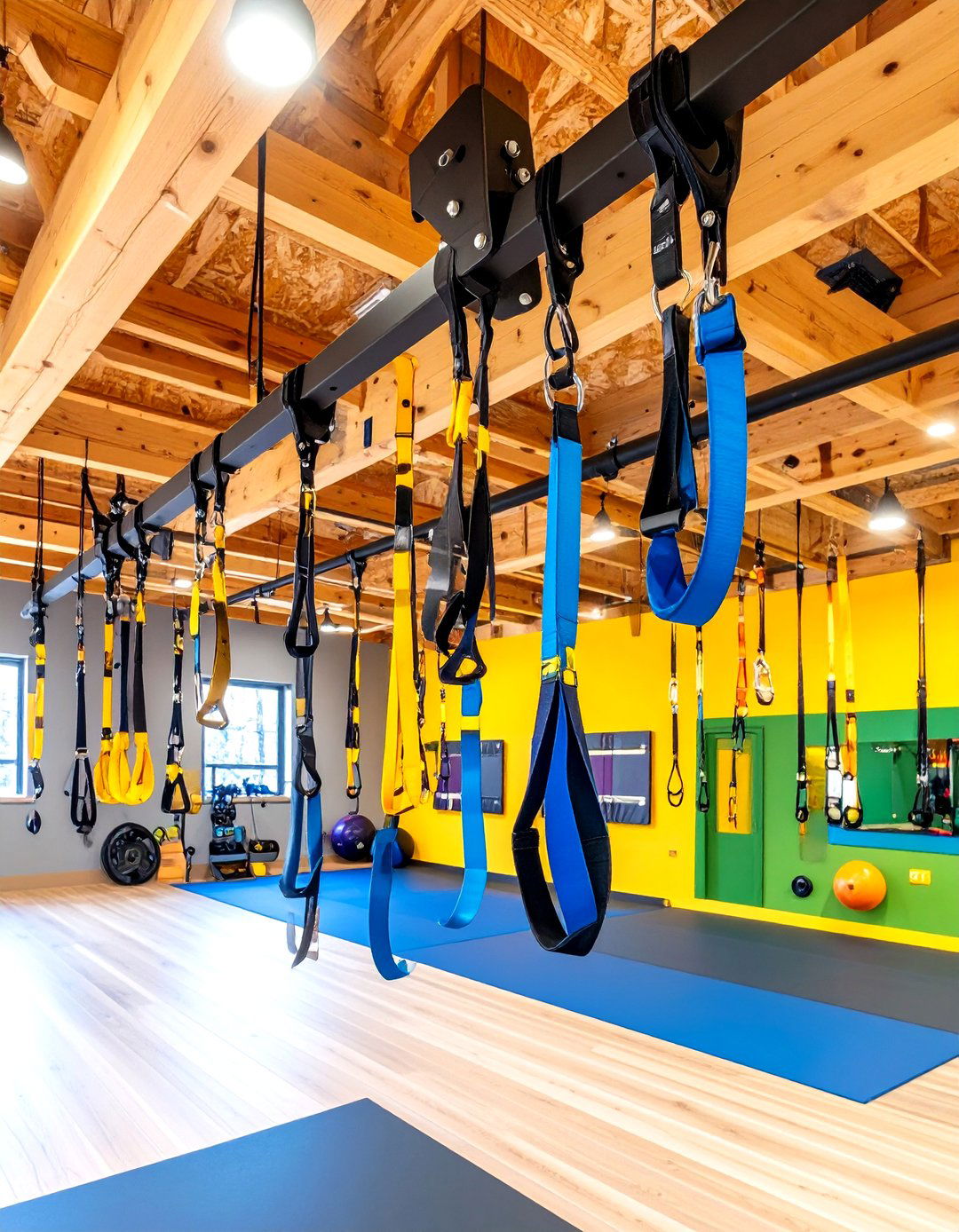
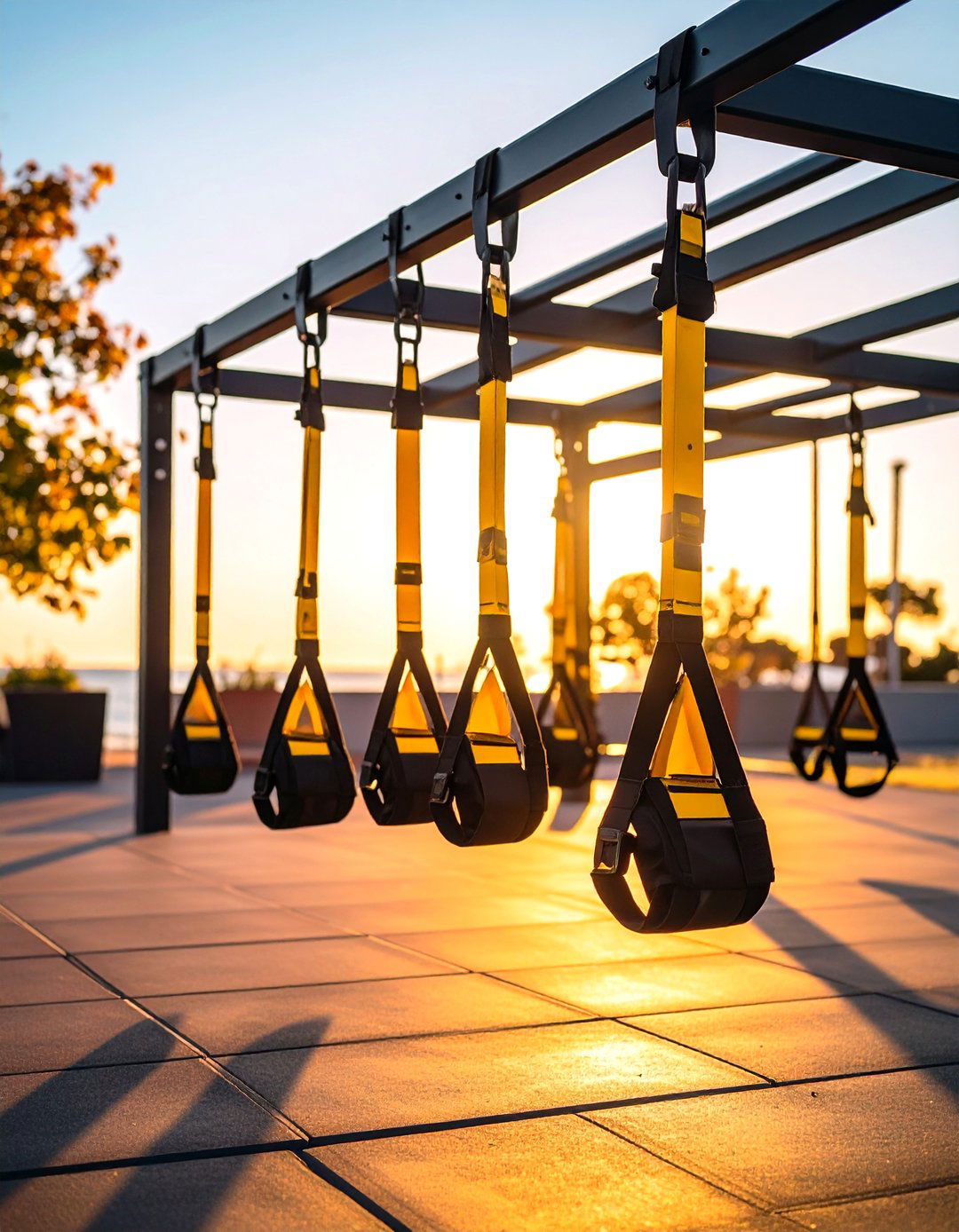
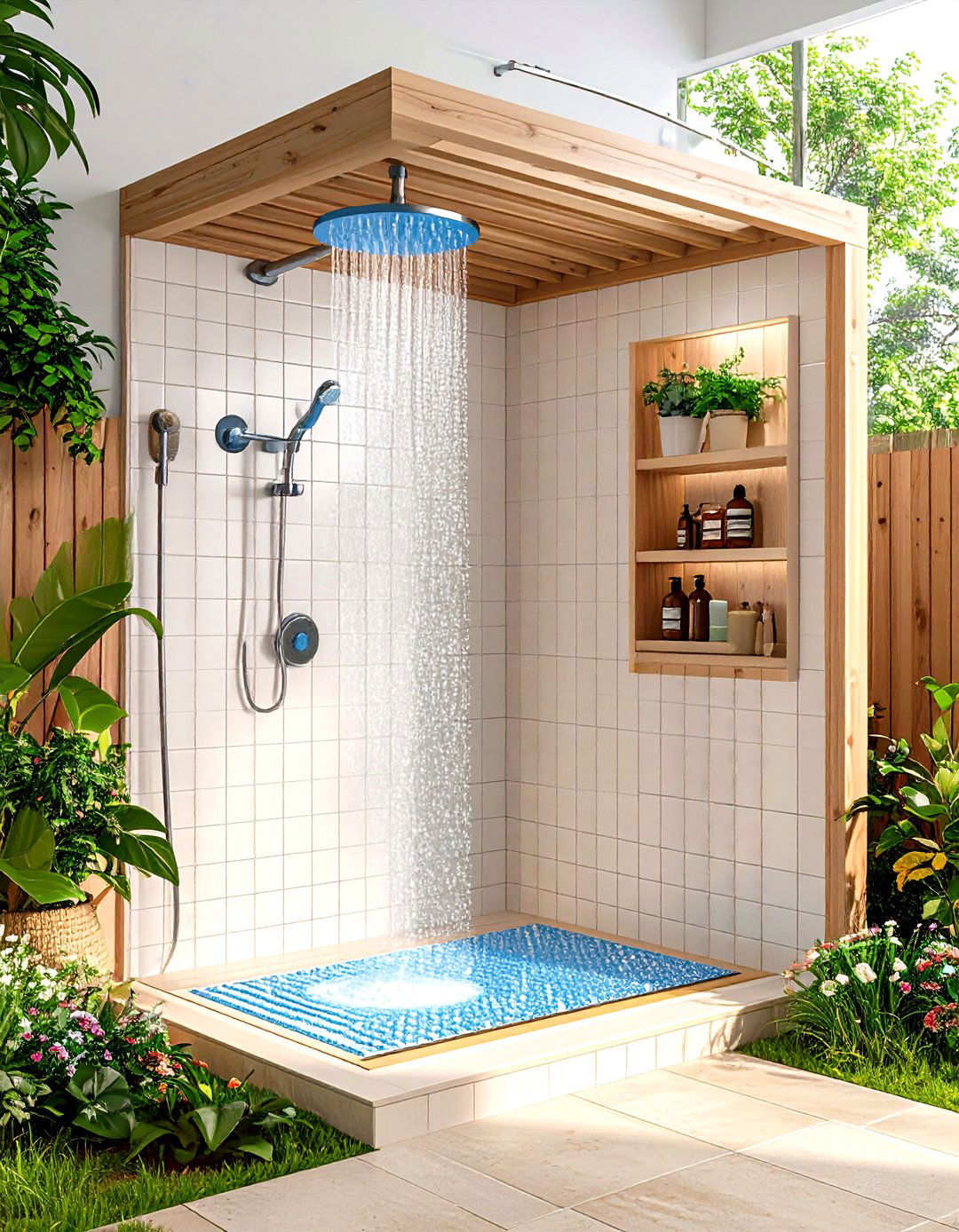
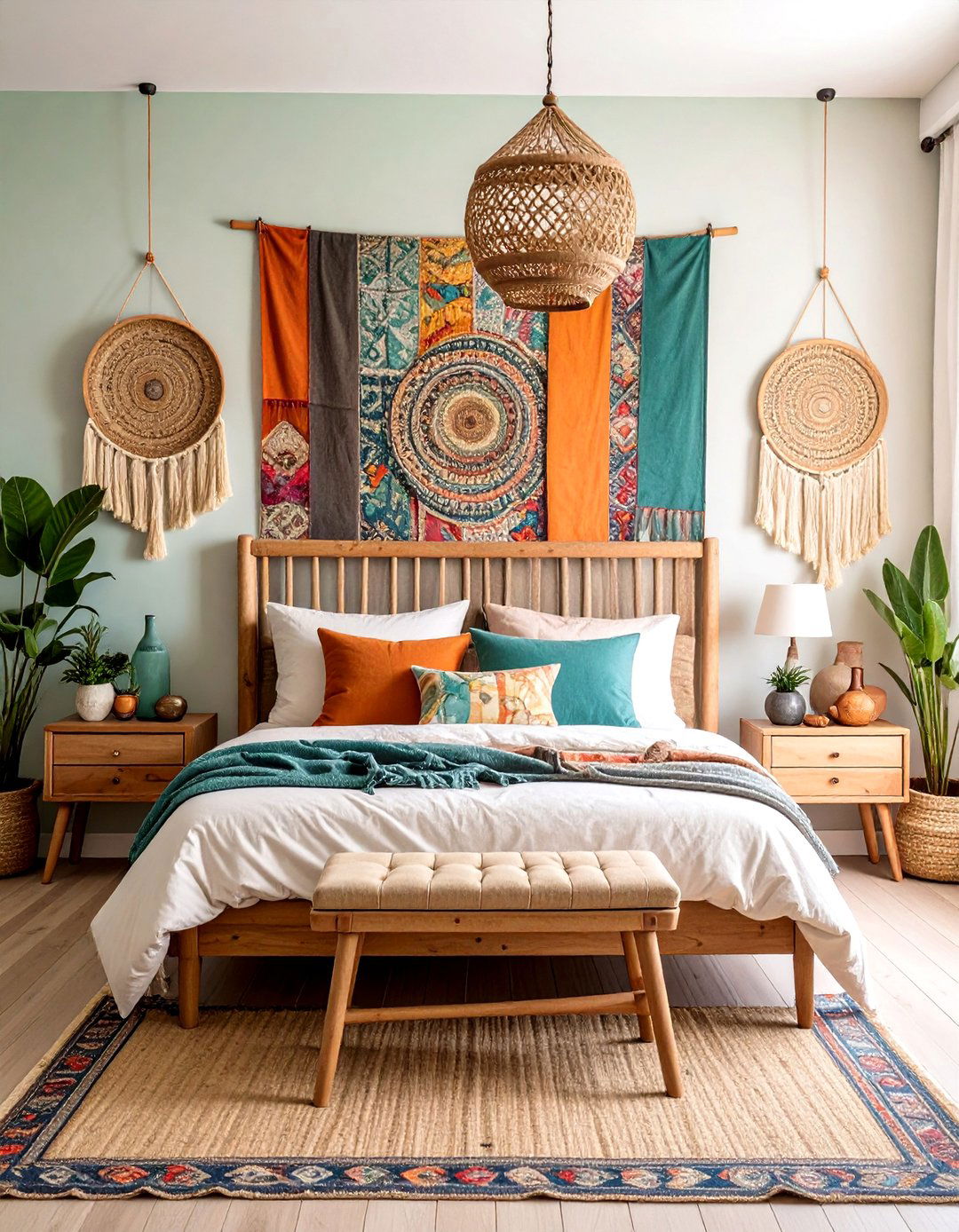




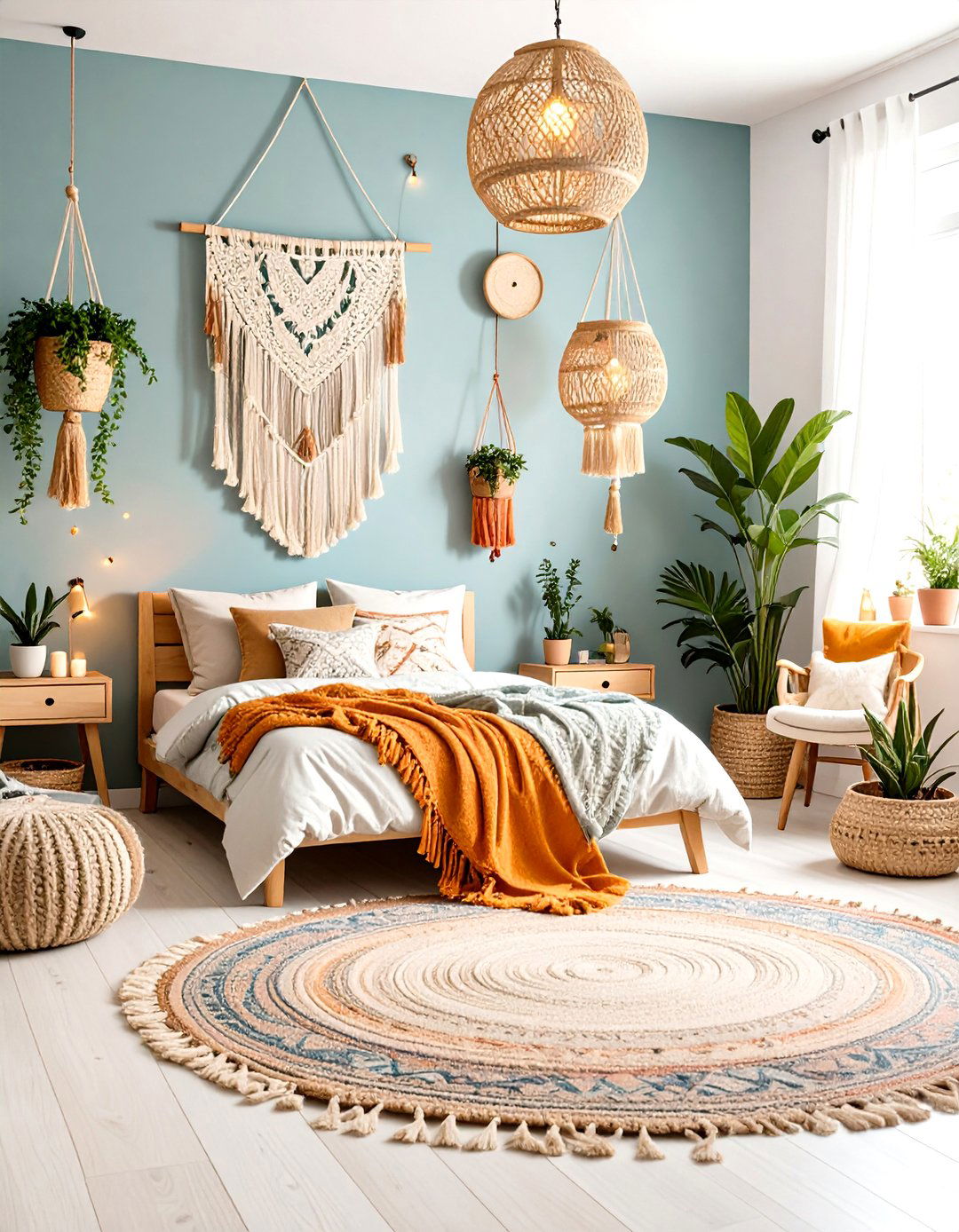



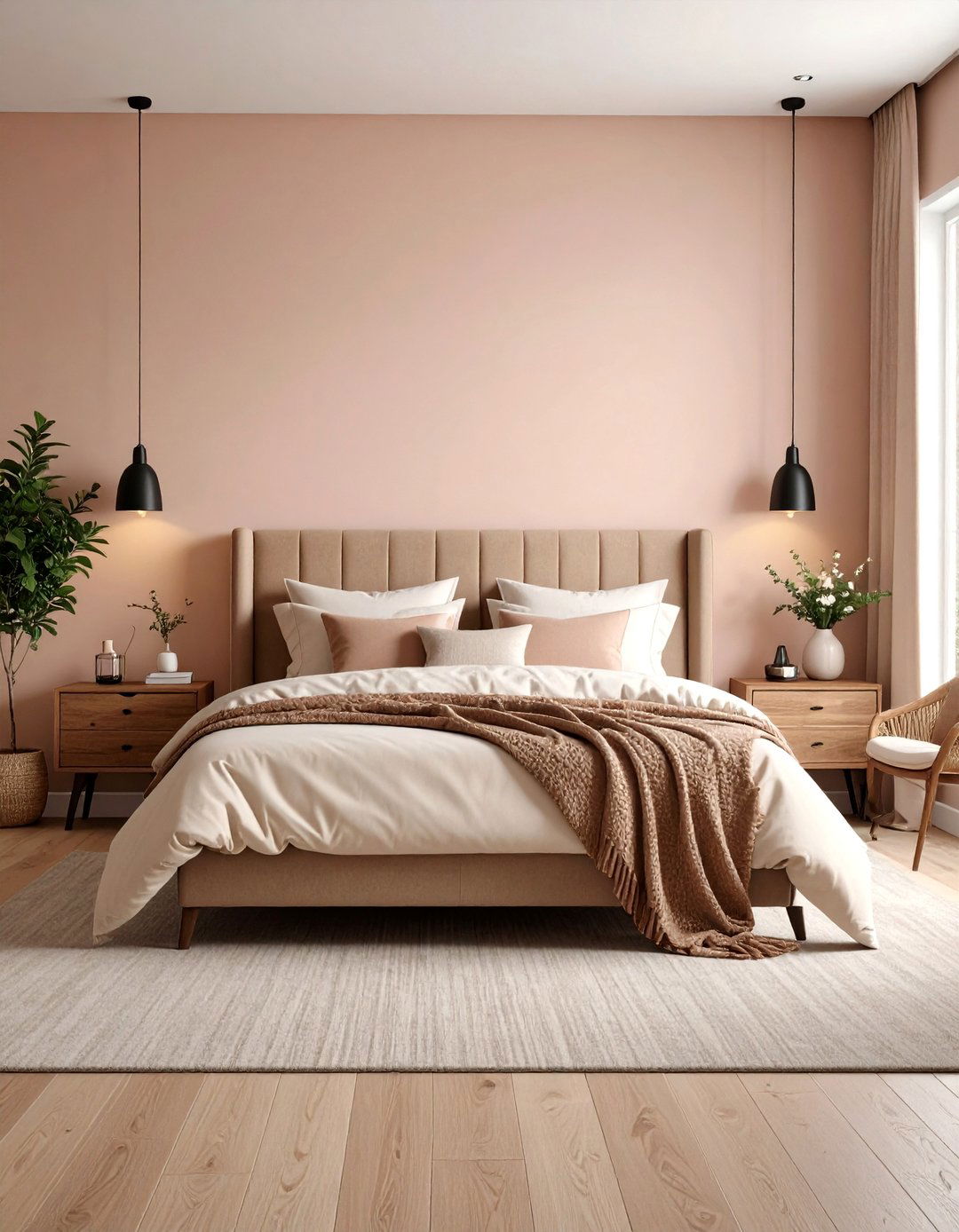

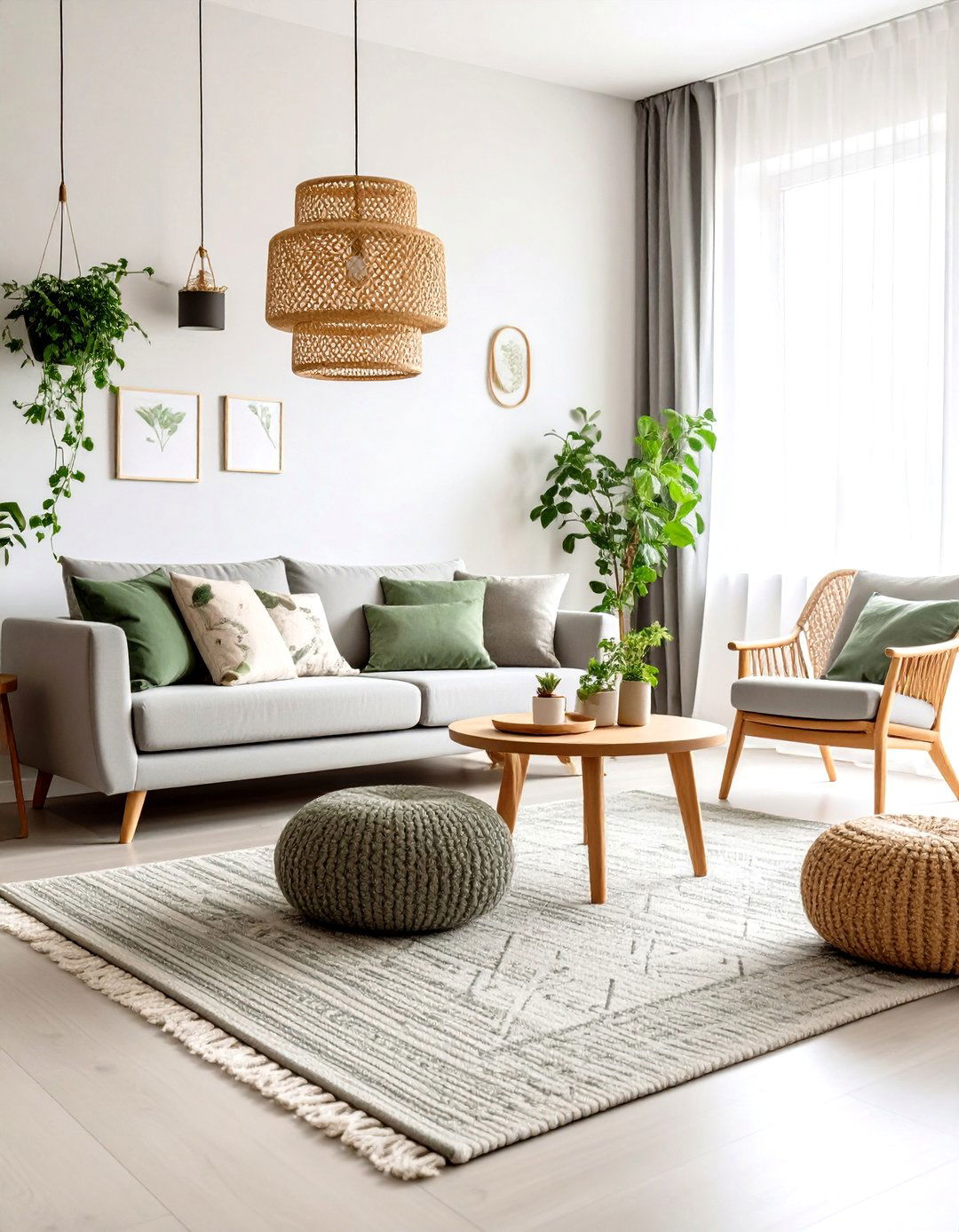
Leave a Reply